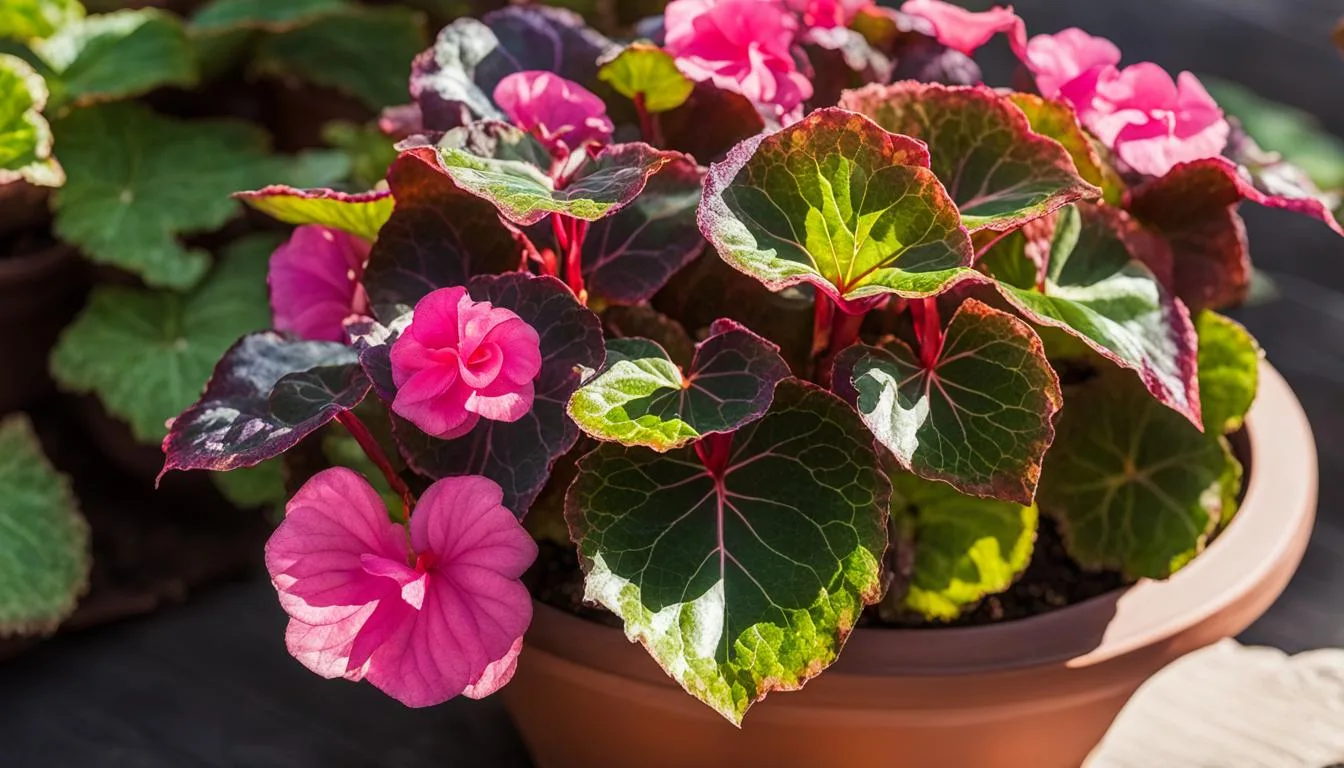
Welcome to my guide on caring for Rex begonias! These stunning plants, also known as painted-leaf begonias or fancy-leaf begonias, are renowned for their vibrant foliage and can bring a touch of beauty to any indoor or shaded garden space.
Rex begonias are semi-tropical perennials that feature large variegated leaves in hues of green, red, silver, and even purple. While they can be challenging to grow, with the right conditions, these plants can truly shine. It’s important to note that Rex begonias are toxic to animals, so keep them out of reach of your furry friends.
In this article, I’ll provide you with all the information you need to successfully care for and cultivate Rex begonias.
Key Takeaways:
- Rex begonias are semi-tropical perennials known for their colorful variegated leaves.
- These plants require specific conditions to thrive, including moderate temperatures, partial to full shade, and well-drained soil.
- Water Rex begonias regularly, allowing the soil to slightly dry between waterings to prevent root rot.
- Feed Rex begonias with a liquid fertilizer at quarter or half strength to promote healthy growth.
- Provide bright indirect light and protect the plants from direct sunlight to prevent leaf burn.
Common Name and Botanical Name
When it comes to Rex begonias, it’s important to know both their common name and botanical name. The common name for these stunning plants is Rex begonia. They are also known as painted-leaf begonias or fancy-leaf begonias. On the other hand, their botanical name is Begonia rex-cultorum, derived from the Begoniaceae family to which they belong.
Common Name: Rex begonia
Botanical Name: Begonia rex-cultorum
These herbaceous, perennial plants can reach a height of 12-18 inches, with a similar spread. Native to Asia, Rex begonias thrive in USDA Hardiness Zones 10-12. It’s important to note that while these plants can bring beauty to your home or garden, they are toxic to pets. So, make sure to keep them out of reach of your furry friends.
Sun Exposure and Soil Type
When it comes to caring for Rex begonias, understanding their sun exposure needs and soil requirements is essential. These plants thrive in partial to full shade, making them perfect for indoor or shaded garden environments. They should be protected from direct sunlight, as it can cause their delicate leaves to burn.
In terms of soil type, Rex begonias prefer well-drained soil with a slightly acidic pH. For container-grown plants, it is recommended to use a porous potting mix. In-ground planting, on the other hand, is best done with well-aerated peat-based potting soil. By providing the right sun exposure and soil conditions, you can ensure that your Rex begonias grow and thrive beautifully.
Sun Exposure
Sun is a key factor in the growth and development of plants. It provides the energy needed for photosynthesis and plays a crucial role in the production of chlorophyll, which gives plants their green color.
Rex begonias prefer partial to full shade, which makes them ideal for indoor or shaded garden environments. While they can tolerate lower light conditions than other begonias, they still require bright indirect light to thrive. It’s important to protect them from direct sunlight, as it can cause their delicate leaves to burn.
Soil Type
The right soil type is essential for the health and well-being of Rex begonias. These plants thrive in well-drained soil with a slightly acidic pH. A porous potting mix is recommended for container-grown plants, as it allows for proper drainage and aeration. In-ground planting is best done with well-aerated peat-based potting soil.
By providing the right sun exposure and soil conditions, you can create an ideal environment for your Rex begonias to grow and thrive.
| Sun Exposure | Soil Type |
|---|---|
| Partial to full shade | Well-drained soil with a slightly acidic pH |
| Bright indirect light | A porous potting mix for container-grown plants |
| Protect from direct sunlight | A well-aerated peat-based potting soil for in-ground planting |
Watering and Feeding
Proper watering and feeding are essential for the health and vitality of Rex begonias. These tropical plants have specific requirements that, when met, will ensure their lush foliage and vibrant colors.
Watering Rex Begonias
Rex begonias prefer consistently moist soil, but it’s important not to overwater them. Allow the top inch of the soil to dry out between waterings to prevent root rot. To maintain the right moisture level, check the soil regularly and water when it feels slightly dry to the touch. When watering, be sure to thoroughly saturate the soil, allowing excess water to drain away.
Feeding Rex Begonias
Feeding Rex begonias with a balanced liquid fertilizer will help promote healthy growth and vibrant foliage. Choose a fertilizer specifically formulated for houseplants or begonias, and dilute it to half strength.
Apply the fertilizer every two weeks during the growing season. Be careful not to overfeed, as this can lead to salt buildup in the soil. Always follow the instructions on the fertilizer packaging for best results.
| Watering Tips | Feeding Tips |
|---|---|
| Water thoroughly, allowing excess to drain away | Choose a balanced liquid fertilizer for begonias |
| Check soil moisture regularly | Dilute fertilizer to half strength |
| Allow top inch of soil to dry out between waterings | Apply fertilizer every two weeks during growing season |
| Prevent overwatering to avoid root rot | Follow fertilizer packaging instructions |
By providing the right amount of water and nutrients, you can ensure that your Rex begonias thrive and display their stunning foliage to the fullest.
Rex Begonia Light Requirements
Proper lighting is crucial for the healthy growth and vibrant foliage of Rex begonias. These plants prefer bright indirect light, which means they should be placed in a location where they receive bright, indirect sunlight for several hours a day. However, it’s important to protect them from direct sunlight as it can cause their delicate leaves to burn.
If you’re growing Rex begonias indoors, placing them near a north or east-facing window is ideal. This will provide them with the right amount of brightness without exposing them to direct sunlight. If natural light is limited, you can also use fluorescent lights to supplement their lighting needs. Position the lights about 12 to 18 inches above the plants for optimum results.
To determine if your Rex begonia is receiving the right amount of light, observe the color and growth of its leaves. The leaves should have vibrant colors and a healthy appearance.
If the leaves appear dull or pale, it may be an indication that the plant is not receiving enough light. On the other hand, if the leaves become scorched or develop brown spots, it’s a sign of too much direct sunlight.
| Light Conditions | Effects on Rex Begonias |
|---|---|
| Bright Indirect Light | Healthy growth, vibrant foliage |
| Direct Sunlight | Burnt leaves, leaf discoloration |
| Insufficient Light | Pale, dull leaves |
Rex Begonia Propagation
Propagating Rex begonias is a rewarding way to expand your collection and share these beautiful plants with others. There are several methods you can use to propagate Rex begonias, including rhizome division, layering, and leaf-tip cuttings.
Rhizome division involves separating the rhizomes, which are thick, underground stems, and replanting them in their own pots. This method is best done in the spring when the plant is actively growing.
Carefully remove the plant from its pot, gently separate the rhizomes, and plant them in fresh, well-draining soil. Ensure each rhizome has at least one healthy stem and root system.
Layering is another effective propagation method for Rex begonias. To propagate using this method, select a healthy and flexible stem with a leaf. Bury a section of the stem in moist soil, leaving the leaf exposed above the soil surface. You can use a small stake or pin to hold the stem in place.
Over time, the buried section of the stem will develop roots. Once the roots have formed, you can carefully cut the stem from the parent plant and transplant it into its own pot.
Leaf-tip cuttings
Leaf-tip cuttings are another popular way to propagate Rex begonias. To do this, select a healthy leaf from the parent plant, making sure it has a visible tip at the end. Cut the leaf off near the base, leaving a short stalk attached. Plant the stalk in a well-draining potting mix, burying it about an inch deep.
Keep the soil consistently moist and place the cutting in a warm, humid environment. After a few weeks, roots will begin to develop, and a new plant will start to grow from the leaf tip.
| Propagation Method | Best Time to Propagate | Requirements |
|---|---|---|
| Rhizome Division | Spring | Healthy rhizomes with stems and roots |
| Layering | Anytime | Flexible stem with a leaf |
| Leaf-tip Cuttings | Anytime | Healthy leaf with a visible tip |
Propagation allows you to create new plants and preserve the unique characteristics of your favorite Rex begonias. With a little patience and care, you can successfully propagate these stunning plants and enjoy their beauty throughout your home or garden.
Ideal Growing Temperature and Humidity
When it comes to growing healthy and vibrant Rex begonias, providing the right temperature and humidity conditions is essential. These plants thrive in moderate temperatures, with optimum daytime temperatures ranging from 60-80 degrees Fahrenheit. Maintaining a relatively cool environment with a nighttime temperature around 60-65 degrees is ideal for their growth and health.
Additionally, Rex begonias prefer moderately high humidity levels of around 50% or higher. This means that creating a humid environment, especially during drier seasons or in dry climates, is crucial.
You can achieve this by using a humidifier, grouping your begonias together to increase humidity, or placing a tray of water near the plants to promote moisture in the air.
Ideal Temperature and Humidity for Rex Begonias
| Temperature | Humidity |
| 60-80°F | 50% or higher |
By maintaining these recommended temperature and humidity levels, you can provide the optimal conditions for your Rex begonias to thrive. Remember to regularly monitor and adjust these factors as needed, particularly in extreme weather conditions or if you notice any signs of stress in the plants. With the right care, your Rex begonias will reward you with their stunning foliage and vibrant colors.
Rex Begonia Potting and Repotting
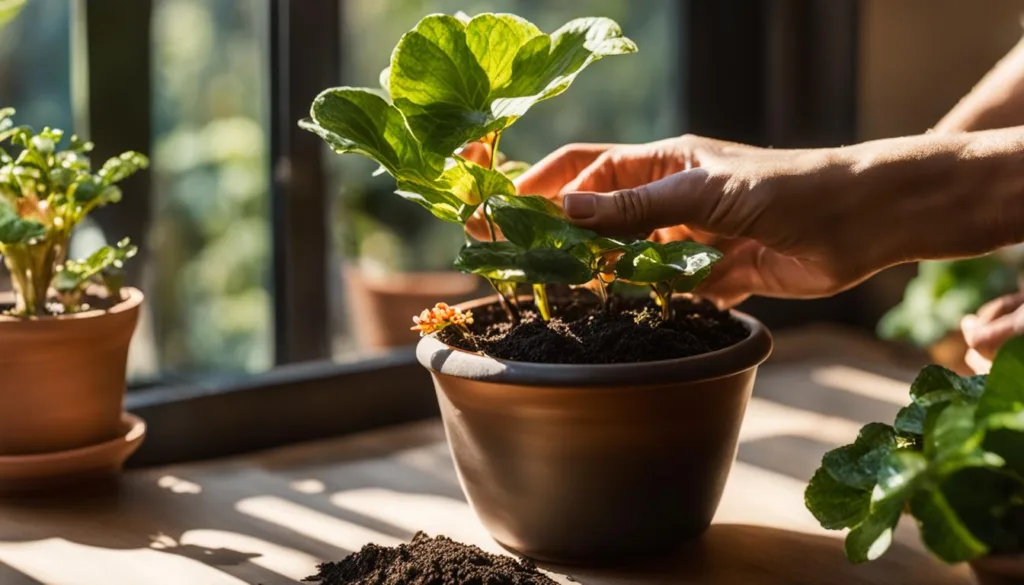
Proper potting and repotting are essential for the health and growth of Rex begonias. These plants have shallow, knobby rhizomes and prefer to be grown in large, relatively shallow pots that allow for proper drainage.
When the rhizome begins to outgrow its current pot, it is important to repot the plant into a fresh pot with fresh soil to provide it with the space and nutrients it needs to thrive.
During the repotting process, it is also an ideal time to divide the rhizome if desired, which can help increase the number of plants you have. Gently separate the rhizomes and ensure that each section has its own stem and roots before replanting them in their own pots. This will give each plant enough space to grow and develop.
When selecting a potting mix for Rex begonias, it is best to choose a well-drained and porous potting mix. A peat-based potting soil that is well-aerated and lightweight is a good choice. This type of soil will allow for proper drainage and prevent the roots from becoming waterlogged, which can lead to root rot.
Potting and Repotting Guidelines for Rex Begonias
| Step | Potting | Repotting |
|---|---|---|
| 1 | Choose a shallow pot with good drainage. | Choose a fresh pot that is larger than the current one. |
| 2 | Fill the pot with a well-drained and porous potting mix. | Remove the begonia from its current pot and gently separate the rhizomes if desired. |
| 3 | Place the begonia in the pot and adjust the soil level so the rhizome is slightly above the surface. | Plant each rhizome section in its own pot, ensuring that each has its own stem and roots. |
| 4 | Water the plant thoroughly after potting. | Water the newly potted plants lightly to avoid overwatering. |
| 5 | Place the pot in a location with bright indirect light. | Monitor the plant closely for the first few weeks and adjust watering as needed. |
Remember to avoid overwatering newly potted plants and keep the soil lightly moist. It is also important to provide the right amount of light and humidity for your Rex begonias to ensure their optimal growth and vibrant foliage. With proper potting and repotting techniques, along with the right care and conditions, your Rex begonias will thrive and bring beauty to your home or garden.
Common Pests and Diseases
Proper care and cultivation of Rex begonias can help prevent common pests and diseases that can affect these beautiful plants. However, it is important to be aware of potential issues and take necessary measures to protect your begonias. Here are some common pests and diseases to watch out for:
Pests:
- Mealybugs: These small, cottony insects can infest Rex begonias and feed on their foliage. Wiping them off with alcohol-soaked cotton swabs or introducing predator insects like ladybugs can help control their population.
- Aphids: These tiny insects can cluster on new growth and cause damage by sucking sap from the leaves. Regularly inspecting your plants and using insecticidal soap or neem oil can help eliminate aphids.
- Spider Mites: These microscopic pests can create fine webbing on the leaves of Rex begonias and cause them to appear yellow or speckled. Spraying the plants with water to increase humidity and using miticides can help manage spider mite infestations.
Diseases:
- Powdery Mildew: This fungal disease can affect Rex begonias, causing a powdery white coating on the leaves. It thrives in humid conditions with poor air circulation. Treating infected plants with a fungicide and improving air circulation can help control powdery mildew.
- Botrytis: Also known as gray mold, this fungus can cause rotting of leaves, stems, and flowers of Rex begonias. Proper watering and good air circulation can help prevent the onset of botrytis. Infected parts should be removed and destroyed to prevent further spread.
- Leaf Spot: This fungal infection causes dark spots on the leaves of Rex begonias. Fungicides and removing infected leaves can help manage leaf spot disease. Avoid overhead watering to prevent the spread of spores.
Regularly inspecting your Rex begonias for signs of pests or diseases, practicing good hygiene, and providing optimal growing conditions can go a long way in preventing and managing problems. Remember to always follow the instructions on any pesticides or fungicides you use and take appropriate safety precautions.
Popular Rex Begonia Varieties
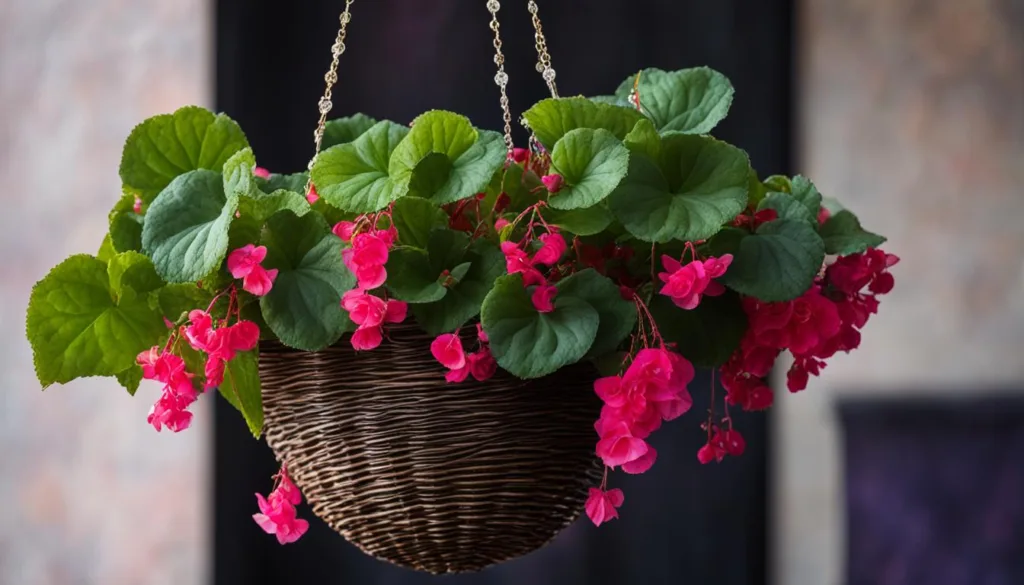
Rex begonias are known for their stunning foliage with a wide range of colors, patterns, and leaf shapes. There are hundreds of hybrids and varieties available in the trade, each with its unique characteristics. Here are some popular Rex begonia varieties:
B. masoniana (Iron Cross Begonia)
This variety features puckered leaves with a dark cross in the middle, resembling an iron cross. Its distinctive leaf pattern adds a bold and striking element to any collection.
B. rex-cultorum hybrids
These hybrids offer a diverse selection of colors and patterns. Some popular varieties include:
- ‘Fireworks’: Known for its vibrant red and silver foliage, resembling fireworks in full bloom.
- ‘River Nile’: Exhibits deep green leaves with silver veins, creating an elegant and mesmerizing effect.
- ‘Cowardly Lion’: Displays rich golden leaves with dark brown markings, resembling the untamed beauty of a lion’s mane.
- ‘Green Gold’: Showcases green leaves with golden accents, adding a touch of luxury to any Rex begonia collection.
- ‘Stained Glass’: Features colorful leaves with intricate patterns, reminiscent of stained glass windows.
- ‘Marmaduke’: Offers large, deeply lobed leaves with a blend of silver, green, and purple hues.
- ‘Escargot’: Named after its unique snail-like leaf shape, this variety exhibits silver leaves with dark green markings.
These popular Rex begonia varieties are just a glimpse of the wide range of options available to plant enthusiasts. Whether you prefer bold and dramatic foliage or subtle and elegant patterns, there is a Rex begonia variety to suit every taste and style.
| Variety | Description |
|---|---|
| B. masoniana (Iron Cross Begonia) | Puckered leaves with a dark cross in the middle |
| ‘Fireworks’ | Vibrant red and silver foliage resembling fireworks |
| ‘River Nile’ | Deep green leaves with silver veins |
| ‘Cowardly Lion’ | Rich golden leaves with dark brown markings |
| ‘Green Gold’ | Green leaves with golden accents |
| ‘Stained Glass’ | Colorful leaves with intricate patterns |
| ‘Marmaduke’ | Large, deeply lobed leaves with silver, green, and purple hues |
| ‘Escargot’ | Silver leaves with dark green markings |
Companion Plants for Rex Begonias
When it comes to creating stunning and harmonious displays with Rex begonias, choosing the right companion plants is key. By selecting plants that complement the vibrant foliage and thrive in similar growing conditions, you can enhance the overall aesthetic appeal of your indoor or shaded garden. Here are some suitable companion plants for Rex begonias:
Silver Dichondra
Known for its silver-green foliage, silver dichondra (Dichondra argentea) provides a beautiful contrast to the colorful leaves of Rex begonias. This trailing plant is an excellent choice for hanging baskets or as a ground cover in shaded areas.
Black Mondo Grass
With its dark, almost black foliage, black mondo grass (Ophiopogon planiscapus ‘Nigrescens’) creates a striking backdrop for the vibrant colors of Rex begonias. This low-growing perennial is ideal for border planting or as a focal point in containers.
Blue Wishbone Flower
Blue wishbone flower (Torenia fournieri) is a delicate annual with blue, purple, or pink flowers that complement the foliage of Rex begonias. It thrives in partial shade and adds a touch of elegance to any garden setting.
Other suitable companion plants for Rex begonias include dwarf elephant’s ear, fiber-optic grass, Friendship plant, Golden St. John’s wort, ‘Persian Chocolate’ moneywort, Rita’s Gold Boston fern, Bowles’ golden sedge, ‘Lime Rickey’ heuchera, Diamond Frost euphorbia, Golden creeping Jenny, ‘Infinity Pink’ New Guinea impatiens, ‘Dark Star’ coleus, Tradescantia, ‘Gartenmeister Bonstedt’ fuchsia, Purple Swedish ivy, and more.
The choice of companion plants ultimately depends on your personal preference and the desired visual impact in your garden.
| Companion Plant | Description |
|---|---|
| Silver Dichondra | Known for its silver-green foliage, provides a beautiful contrast to the colorful leaves of Rex begonias. Ideal for hanging baskets or ground cover. |
| Black Mondo Grass | With its dark, almost black foliage, creates a striking backdrop for the vibrant colors of Rex begonias. Ideal for border planting or as a focal point. |
| Blue Wishbone Flower | Delicate annual with blue, purple, or pink flowers that complement the foliage of Rex begonias. Ideal for partial shade. |
| Dwarf Elephant’s Ear | Low-growing perennial with large, elephant ear-shaped leaves. Adds a tropical touch to the garden. |
| Fiber-Optic Grass | Grass-like perennial with thin, wiry leaves that resemble fiber-optic strands. Adds texture and interest to plantings. |
| Friendship Plant | Trailing plant with small, round leaves patterned with silver veins. Creates a lush and cascading effect. |
| Golden St. John’s Wort | Perennial with bright yellow flowers and golden-green foliage. Thrives in full sun to partial shade. |
Note: Before combining plants, consider their individual light and water requirements to ensure they can coexist harmoniously in the same growing conditions.
Caring for and cultivating Rex begonias can be a rewarding experience. These beautiful plants, with their vibrant foliage and wide range of varieties, can thrive indoors or in shaded garden environments. By providing them with the right conditions, such as the proper temperature, light, water, and soil, you can ensure that your Rex begonias remain healthy and vibrant.
Remember to keep the temperature within the ideal range of 60-80 degrees Fahrenheit during the day and around 60-65 degrees Fahrenheit at night. Rex begonias prefer bright indirect light and thrive in moderately high humidity levels, around 50% or higher.
Proper watering is important, keeping the soil slightly moist but not overly wet, and feeding them regularly with a liquid fertilizer will help keep them nourished.
Additionally, it’s important to be aware of common pests and diseases that can affect Rex begonias. Mealybugs can be controlled by wiping them off with alcohol or introducing predator insects, while powdery mildew and botrytis fungal diseases can be treated with a systemic fungicide.
Keeping a good air circulation, removing dead leaves, and providing the right environment can help prevent diseases.
With a little care and attention, your Rex begonias can be the stars of any indoor or shaded garden. So go ahead and enjoy the beauty and color they bring to your space!
FAQ
What are the common names and botanical name of Rex begonia?
Rex begonia is also commonly known as painted-leaf begonia or fancy-leaf begonia. Its botanical name is Begonia rex-cultorum.
What type of sun exposure and soil does Rex begonia prefer?
Rex begonias prefer partial to full shade and thrive in well-drained soil with a slightly acidic pH.
How often should Rex begonias be watered and fed?
Rex begonias should be watered regularly to keep the soil slightly moist but not overly wet. The soil should be allowed to dry slightly between waterings. Regular feeding with a liquid fertilizer is recommended, applied weekly at quarter strength or every two weeks at half strength.
What are the light requirements for Rex begonias?
Rex begonias prefer bright indirect light year-round and can tolerate lower light conditions than other begonias. They should be protected from direct sunlight to prevent leaf burn.
How can Rex begonias be propagated?
Rex begonias can be easily propagated through rhizome division, layering, or leaf-tip cuttings. Rhizome division involves separating the rhizomes and replanting them in their own pots. Layering involves bending a stem with a leaf into the soil and pinning it down until it grows roots. Leaf cuttings can be taken by planting the stalk of a leaf into the soil.
What are the ideal growing temperature and humidity for Rex begonias?
Rex begonias thrive in moderate temperatures, with optimum daytime temperatures ranging from 60-80 degrees Fahrenheit. They prefer a relatively cool environment with a nighttime temperature around 60-65 degrees. They also thrive in moderately high humidity, with a humidity level of around 50% or higher being ideal.
How should Rex begonias be potted and repotted?
Rex begonias have shallow, knobby rhizomes and prefer to be grown in large, relatively shallow pots. When the rhizome outgrows its current pot, it is time to repot the plant into a fresh pot with fresh soil. During repotting, the rhizome can be divided to increase the number of plants.
What are the common pests and diseases that affect Rex begonias?
Common pests that can affect Rex begonias include mealybugs, powdery mildew, and botrytis fungal disease. Mealybugs can be controlled by wiping them off with alcohol or introducing predator insects. Powdery mildew and botrytis fungal disease can be treated with a systemic fungicide. Regularly removing dead leaves and providing good air circulation can help prevent diseases.
What are some popular varieties of Rex begonias?
Some popular varieties of Rex begonias include B. masoniana (iron cross begonia) and B. rex-cultorum hybrids such as ‘Fireworks’, ‘River Nile’, ‘Cowardly Lion’, ‘Green Gold’, ‘Stained Glass’, ‘Marmaduke’, and ‘Escargot’. These varieties showcase a range of colors, patterns, and leaf shapes.
What are some companion plants that can be paired with Rex begonias?
Some suitable companion plants for Rex begonias include silver dichondra, black mondo grass, Blue wishbone flower, dwarf elephant’s ear, fiber-optic grass, Friendship plant, Golden St. John’s wort, ‘Persian Chocolate’ moneywort, Rita’s Gold Boston fern, Bowles’ golden sedge, ‘Lime Rickey’ heuchera, Diamond Frost euphorbia, Golden creeping Jenny, ‘Infinity Pink’ New Guinea impatiens, ‘Dark Star’ coleus, Tradescantia, ‘Gartenmeister Bonstedt’ fuchsia, Purple Swedish ivy, and more.

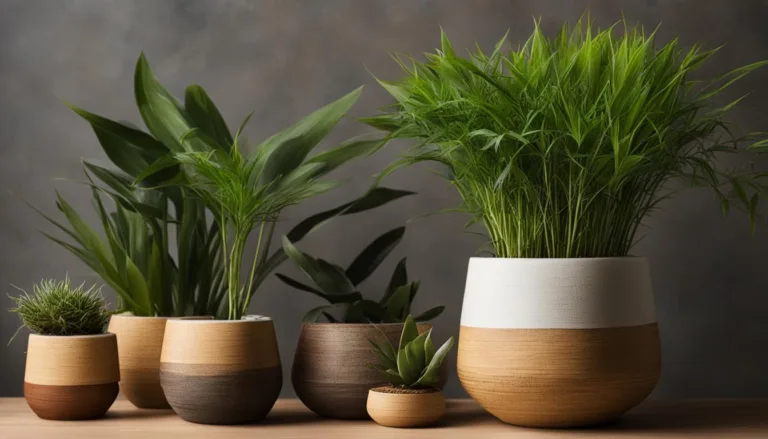

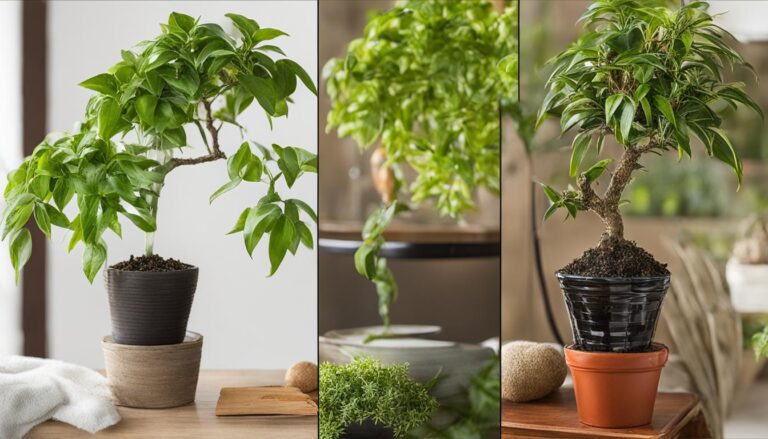
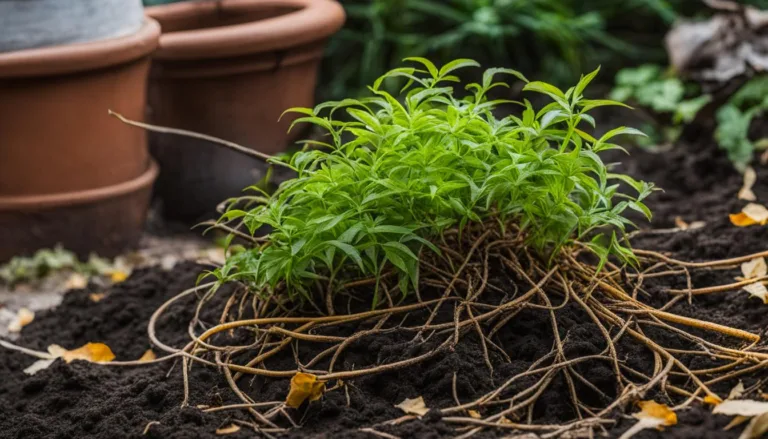
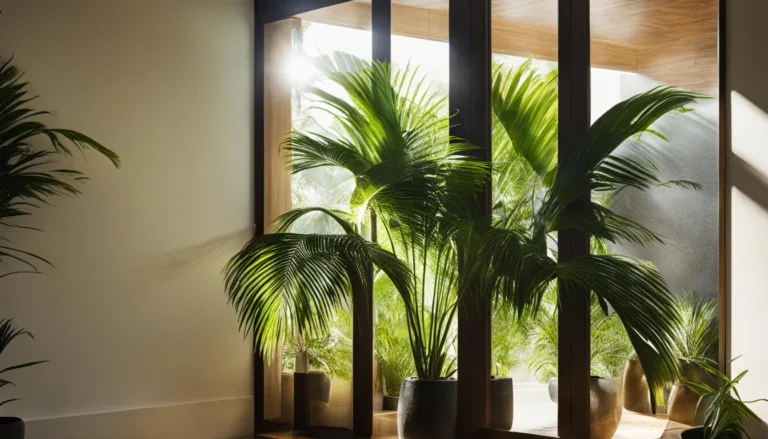
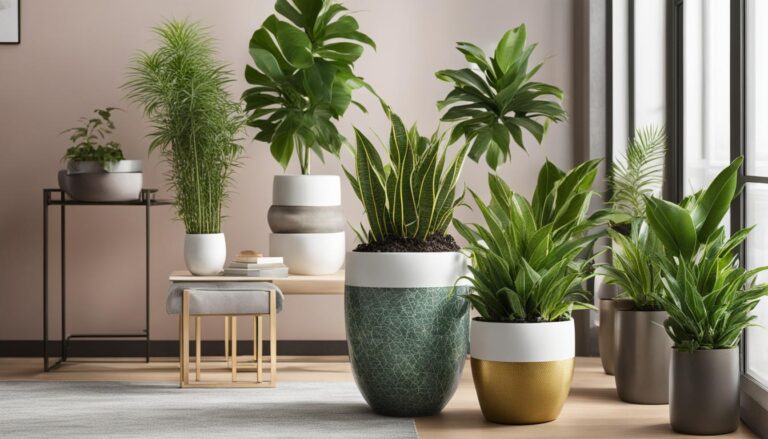
Somebody essentially lend a hand to make significantly posts I might state That is the very first time I frequented your web page and up to now I surprised with the research you made to create this particular put up amazing Excellent job
Recently I found this great website, they create engaging content for their audience. The site owner excels at informing customers. I’m excited and hope they keep up their magnificent skills.